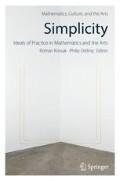Abstract
On April 4th, 2013, we heard Juhani Pallasmaa’s presentation, “The complexity of simplicity,” about phenomenology and art. I’m sure others agree with me that it was a highlight of the symposium. Earlier I had spoken about mathematics, mostly about Bolzano, Gauss, and Hilbert. As chance would have it, I used the same title. I have chosen a different title for this redaction, but I want to motivate the remarks ahead by recalling how architectural theory and the history of mathematics were discussed in many of the same terms, and under the same banner, that morning.
Access this chapter
Tax calculation will be finalised at checkout
Purchases are for personal use only
References
Aristotle. Posterior Analytics. 2nd ed. Translated with a commentary by Jonathan Barnes. Oxford: Clarendon Press, 1994.
Bachelard, Gaston. La Poétique de lÉspace. Paris: Presses Universitaires de France, 1958.
Benedict, Richard. Patterns of Culture. New York: Houghton Mifflin, 1934.
Bolzano, Bertrand. “Betrachtungen über einige Gegenstände der Elementargeometrie.” In [10].
———. “Beyträge zu einer begründeteren Dartellung der Mathematik.” Translated by S. Russ in [10], 174–224.
Bourdieu, Pierre. “The historical genesis of a pure aesthetic.” The Journal of Aesthetics and Art Criticism 46 (1987): 201–210.
Cantor, Georg. “Grundlagen einer allgemeinen Mannigfaltigkeitslehre.” Translated in [10].
Danto, A. “The artworld.” The Journal of Philosophy 61, no. 19 (1964): 571–584.
Dedekind, Richard. “Was sind und was sollen die Zahlen?” Translated in [10].
Ewald, William. From Kant to Hilbert: A Sourcebook in the Foundations of Mathematics, vols. I and II. New York: Oxford University Press, 1996.
Gauss, Carl Freidrich. “Theoria residuorum biquadraticorum, Commentatio secunda.” Translated in [10].
Hilbert, David. Foundations of Geometry. Translated by E. J. Townsend. 3rd ed. La Salle, IL: Open Court, 1938.
Danto, A.. “Mathematical Problems.” Reprinted in [10].
Poincaré, Henri. “On the nature of mathematical reasoning.” Reprinted in [10].
Rota, Gian Carlo. “The pernicious influence of mathematics upon philosophy.” Synthese 88, no. 2 (1991): 165–178.
Sacks, Harvey. “On doing ‘being ordinary.”’ Structures of Social Action: Studies in Conversational Analysis. Edited by J. Maxwell Atkinson and John Heritage. New York: Cambridge University Press, 1984.
Schegloff, Emanuel. “The routine as achievement.” Human Studies 9 nos. 1–2 (1986): 111–151.
Sylvester, James. “Presidential address to Section ‘A’ of the British Association.” Reprinted in [10].
Thurston, W. “On proof and progress in mathematics.” Bulletin of the American Mathematical Society 30, no. 2 (1994): 161–177.
Wittgenstein, Ludwig. Philosophical Investigations. 2nd ed. Translated by G. E. M. Anscombe. Oxford: Blackwell, 2001 (1953).
Author information
Authors and Affiliations
Corresponding author
Editor information
Editors and Affiliations
Rights and permissions
Copyright information
© 2017 Springer International Publishing AG
About this chapter
Cite this chapter
Franks, C. (2017). Constructing the Simples. In: Kossak, R., Ording, P. (eds) Simplicity: Ideals of Practice in Mathematics and the Arts. Mathematics, Culture, and the Arts. Springer, Cham. https://doi.org/10.1007/978-3-319-53385-8_6
Download citation
DOI: https://doi.org/10.1007/978-3-319-53385-8_6
Published:
Publisher Name: Springer, Cham
Print ISBN: 978-3-319-53383-4
Online ISBN: 978-3-319-53385-8
eBook Packages: Mathematics and StatisticsMathematics and Statistics (R0)

